NOVEMBER 16, 2020
From her home in south Dallas, she watched it grow until it towered at 60 feet tall and spread all the way to her backyard, “a few feet from my bedroom.”
The mountain is human-made — an environmental nightmare of discarded roofing shingles stretching more than a city block. Even though it’s an illegal toxic waste dump on the edge of a neighborhood, it took months of pressure to get city officials to even acknowledge its existence and finally make plans to take it down.
Shingle Mountain didn’t just appear from out of nowhere. It formed just south of a section of Dallas settled by formerly enslaved people, an area that for more than a century has been zoned for everything White citizens didn’t want in their neighborhoods: industrial rail yards, chemical plants, concrete mixing facilities, warehouses that lure up to 100 diesel trucks per day and a massive landfill.
And now, even as Dallas is currently more than 60 percent Latino and African American, with a Black city manager and mayor and a diverse city council, redlining and other historic land-use decisions by White leaders and planners who are long gone continue to have a lasting negative impact.
When two White business partners looked at the area in 2017, they figured it was an ideal place to start a dump. They redirected truckers hauling shingles to the landfill and charged them a fee to unload their cargo on their vacant land instead. One of the partners set up an illegal recycling operation that ground black shingles into dust, a process that spewed toxins and fine particulate matter into the air around Jackson and about 100 of her neighbors.
With so much industry already in south Dallas, city officials didn’t notice even when it reached the height of a six-story building. Over the course of seven months starting in January 2018, Jackson complained to the city, and no one answered.
Jackson, 62, is certain that particulate matter from the shingles is in the air she and her 12-year-old granddaughter have been breathing for two years. Her voice comes and goes, she says, because “it gets up in my throat.”
Recent studies have shown that minority residents in Dallas breathe more polluted air than White residents and have a significantly shorter life expectancy.
That finding fits with a reality nationwide reflected in other studies. Black and Latino residents in the United States are far more likely than White people to live near landfills, power plants, concrete mixing facilities and other sources of emissions that foul the air.
And they are far more likely than White people to die from exposure to pollution.
Whites are mostly to blame for air pollution, but Blacks and Hispanics bear the burden, study finds“It could not be more crystal clear,” said Chris Dowdy, the vice president for academic affairs at Paul Quinn College, a historically Black university in south Dallas that participated in a study called “Poisoned by Zip Code.” “You can draw a straight line from where Black folks gathered after emancipation to the redlining maps, to where you’re more likely to be poisoned because of zoning, and where people die earlier.”
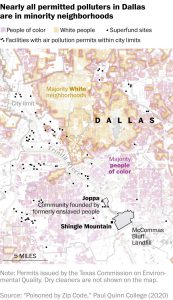
‘A hellish scene’
Shingle Mountain seemed like a great business idea to Christopher Ganter and Cabe Chadick.
It was 2017, and Ganter was repairing Chadick’s roof in McKinney, Tex. when the repairman said he had an idea to recycle shingles. “He talked about the positive environmental impact and how there was a location in south Dallas he had in mind,” Chadick said, according to one of the lawsuits they now face.
They drove to a chunk of land off Highway 310 near the McCommas landfill. Ganter wagered that truckers hauling shingles would gladly pay a higher fee to dump at the site rather than endure the long waits and paperwork required at McCommas Bluff.
Time was money.
Ganter had another big idea. He could use his Blue Star Recycling company to shred the shingles and make a goo that could fill potholes. The shredder would gnaw at the leathery tiles and spit dust and debris into the sky.
Chadick was so impressed with the idea that he purchased the land for $465,000 and leased it to Blue Star for $5,500 a month for 10 years. The pair did not obtain the necessary state permits for any of it.
According to the city’s hazardous waste analysis, shingles contain tiny glass fibers and formaldehyde that go airborne when they’re ripped apart.
Breathing dust from crushed asphalt shingles “may cause temporary irritation of the nose and throat,” it said. “Ingestion may cause short term … irritation of the stomach and intestines. Vomiting may occur.”
Ganter, 46, and Chadick, 51, did not respond to requests for comment.
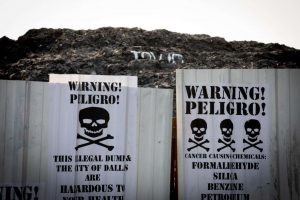
Protest signs pasted on the gate outside the mountain of shingles at the former Blue Star Recycling site in Dallas.
In January 2018, Jackson started complaining. It was 11 months before anyone listened. Near the end of that year, Jackson was invited to a December meeting of an environmental group called Downwinders at Risk, which works in Joppa, a section of the city settled by formerly enslaved people in 1872. She told her story.
Jim Schermbeck, the environmental group’s director, rushed to the site the next day.
“The scene couldn’t have been more hellish,” Schermbeck said. “Trucks going in and two industrial size grinders taking whole shingles and grinding them up and spewing a huge cloud of gray dust throughout the area.”
Schermbeck reached out to six local reporters to bring attention to the issue. Robert Wilonsky of the Dallas Morning News responded. His column published in mid-December finally got Dallas officials to notice.
“I got in my car and went out there,” said Tennell Atkins, the Black city council member of the district where the dump sits.
Atkins tried to explain how city officials somehow missed a toxic mountain weighing 100,000 tons and rose so high that it could be seen a half-mile away from a local freeway.
“This is what you don’t understand,” Atkins said in an interview with The Washington Post. “My district is 58 square miles. It’s difficult to police. I have a whole lot of illegal dumping because it’s so huge.”
District 8 has so many industrial sites that an illegal mountain of pollution at first might not seem out of place, Atkins said. It’s a food desert with nearly as many dumps as grocery stores and sit-down restaurants.
Trump has rolled back 125 environmental safeguards. Here’s how.
The area is so forsaken that residents in Dallas County drive for miles to abandon unwanted dogs. In 2016, a homeless woman was mauled to death by a pack of stray dogs. About two years later, Vincent Owoseni, a valedictorian at Paul Quinn College, ran for his life when stray dogs chased him on campus, school officials said.
But not everyone bought Atkins’s argument that his district’s problems provided cover for a 60-foot-tall abomination.
“There’s no way that he didn’t know,” said Kevin Felder, a former city council member who is Black.
A certificate of occupancy issued by the city to Ganter and Chadick is evidence that he knew, said Felder, who represented the district next door before leaving office last year. An industrial zoning permit request requires a public hearing the district’s council member is responsible for conducting.
“As a council person, nothing happens in that district that you don’t know about.”
Schermbeck also said Atkins’s lack of awareness defies belief. But he was more concerned with why anyone would pile so much pollution alongside a woman’s home.
“They had absolutely no pollution controls, and they were doing this next to her with only a barbed wire fence,” Schermbeck said.
“I said there is no way this is legal.”
‘A new Confederate monument’
The lawsuits started rolling in.
The city was the first to go to court in December 2018, naming Ganter, Chadick and the owner of another nearby property who also used his land as a toxic solid waste dump in a complaint.
Then in March this year, the state intervened in the city’s suit and charged the men with “unauthorized acceptance, storage and disposal of solid waste.”
Four months later, Jackson sued Ganter and Chadick. After learning that the city granted the men a certificate to operate, her lawyers added Dallas to the claim.
“The city of Dallas defended this as a legal operation until March 2019,” Schermbeck said. “We argued with the city of Dallas for four months that this was an illegal operation. They didn’t acknowledge it until we threatened civil action.”
Jackson didn’t ask for money. She just wanted Shingle Mountain gone. She wanted her voice to stop going in and out. And she wanted to get rid of the faint smell of petroleum that wafted when the wind gathered.
At first, the courts moved fast. State District Judge Gena Slaughter ordered Ganter and Chadick to cease operations and haul away the shingles. A $1,000-per-day fine was imposed until the work was done.
But Ganter refused to pay. He declared bankruptcy, shut down Blue Star Recycling and walked away, saying he couldn’t afford the half-million dollar estimated cost of removal.
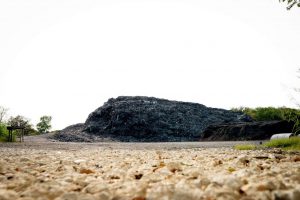
The Dallas City Council recently approved a contract to remove Shingle Mountain.
Last month, nearly two years after Jackson first complained, the Dallas City Council approved a $480,000 contract to remove Shingle Mountain. City lawyers said they are working with the state to negotiate a settlement with the landowners to help fund the cleanup.
But critics say officials should have responded sooner to Jackson’s complaints.
Michael Phillips, author of “White Metropolis,” a history of how White power brokers excluded African Americans from politics, said it’s not surprising that a Black woman’s voice was not heard.
Dallas is a city with a significantly racist past that was overshadowed by events in the Deep South.
“Shingle Mountain to me represents a new Confederate monument that symbolizes the white supremacist mind-set in Dallas since it was established as a village in the 1840s,” Phillips said.
‘Disparity in Dallas’
When Jackson moved near Joppa in south Dallas 25 years ago, she stepped into the epicenter of the city’s fraught racial history.
It started before the Civil War, when downtown Dallas burned to the ground and enslaved people were blamed. White residents suspected a rebellion, so “every single enslaved person in Dallas was flogged,” Phillips said.
Texas was among the most vehement proslavery states in the Union.
As the other slaveholding states such as Mississippi and Louisiana fell to federal troops, enslavers struck out with their servants for Texas, which declared itself a haven where the institution would never end. Juneteenth, the Black freedom holiday, started in Galveston after Texas resisted emancipation years after it was decreed.
Juneteenth celebrates ‘a moment of indescribable joy’: Slavery’s end in TexasJoppa [pronounced Jop-pee] was settled seven years after the Emancipation Proclamation went into effect in 1865. White rioters in Dallas captured the brutal 1910 lynching of Allen Brooks on a postcard that was mailed across America. In the next decade, “Dallas … had the largest per capita Ku Klux Klan chapter in the United States,” Phillips said.
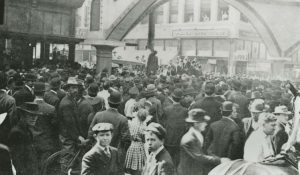
Smithsonian National Museum of African American History and Culture Black and white photograph of the lynching of Allen Brooks in Dallas on March 3, 1910.
A group of wealthy White business leaders formed the Dallas Citizens Council (DCC) in 1937 and set out to influence every aspect of the city’s development.
“The DCC decided who would be mayor, and they handpicked the city council from the 1930s certainly until the 1960s,” Phillips said.
Sarah Jackson, a spokeswoman for the DCC, said there are now numerous African Americans and Latinos on its board, including the Black chairman. The notion that the citizens council swayed elections is mistaken, she said. A separate group, the Citizens Charter Association, formed election slates.
“They were one and the same,” said W. Marvin Dulaney, deputy director and chief operations officer for the African American Museum of Dallas. “The citizens charter was an arm of the council.”
Working together, the business groups created a weak mayor system and at-large council seats, guaranteeing that only White people would be elected.
Black activists fought for more than a half-century for district elections and finally gained a seat on the council in 1967, Dulaney said, when African Americans and Latinos made up a third of the population and were rapidly growing.
By that time, the southern half of Dallas had been eviscerated by zoning and neglect, and Joppa declined.
“Joppa was Dallas’s stepchild,” said Donald Payton, a historian who focuses on the Black community. “Some people didn’t get running water. Outdoor toilets, no paved streets, Black communities that the city ignored for years and years, up to today.”
A growing Dallas needed industry, and most of it went there. “You started having plants put up where Black people were living — concrete plants, lead smelter factories and dumping grounds,” Payton said.
In a Dallas Morning News column this year, Mark Lamster found a statement that revealed the mind-set of White leaders near the turn of the 20th century and how their attitudes influenced zoning that shaped the city for years to come.
The Kessler Plan Association, which guided an effort known as City Beautiful to develop Dallas, said in 1926 that “whites who have bought homes are entitled to protection from encroachment of Negroes moving into the neighborhood.”
“Land set aside for African Americans was considered undesirable: in the Trinity [River] floodplain, adjacent to industrial uses,” Lamster wrote. “Then came the highways — the R.L. Thornton Freeway, Central Expressway, Interstate 30, the Dallas North Tollway — which plowed through those minority neighborhoods for the convenience of the region’s white commuter population.”
Without power and a political voice, African Americans and Latinos watched it happen.
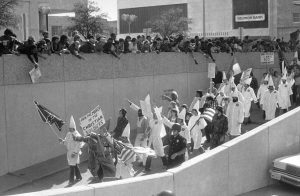
AP Hecklers jeers as Ku Klux Klan members walk down the ramp at the Dallas county courthouse at the end of their parade Nov. 4, 1979.
Dallas was a city that the civil rights movement seemed to pass by. Long after the Deep South cities of Atlanta, New Orleans and Birmingham, Ala., elected Black mayors in the 1970s, Dallas residents waited. Ron Kirk didn’t become the city’s first Black mayor until 1995.
“The city of Dallas is the ninth largest city in America. We are a tale of two cities,” said Atkins, the city councilman. “We are trying to do something about it. There is a disparity in the city of Dallas.”
In his 1987 book, “The Accommodation,” journalist Jim Schutze sought to tell the story of how Black political representation was stunted in Dallas. It alleged that the citizens council used payoffs to persuade the city’s Black ministers to not participate in the civil rights movement.
Weeks before publication, the book was dropped by its publisher on the grounds that not enough copies were sold. But Schutze, who had predicted it would be hard to get the book past the Dallas political establishment, wasn’t surprised.
“The Dallas Citizens Council got it killed,” said the author, a claim that the citizens council has denied.
”Jim is saying things about Dallas that aren’t all nicey-nicey,” Robert Frese, the book’s editor, told the New York Times at the time. ”And it’s so image-conscious here, you can’t say anything negative.”
The book was published without fanfare in North Carolina, but today copies are so rare that they sell for $650 to $1,000 each. In 2015, D Magazine dubbed it “the most dangerous book in Dallas.”
Minority areas already have high pollution. Trump’s coronavirus response makes it worse, critics say.
At Paul Quinn College, Black students keep getting drafted into the war against pollution.
When the city sought to expand the landfill in 2012, “we would cancel classes and go protest,” said Michael Sorrell, the college’s president.
“Where else would a four-year college be within two miles of the city dump? Who does that?” Sorrell said. “All too often these decisions are racially motivated.”
And the consequences can be deadly, experts say.
According to “Poisoned by Zip Code,” nearly 300 industrial sites emit pollution in Black and Latino Dallas.
The district where Shingle Mountain sits has the highest levels of particulate matter pollution. Other mostly minority districts nearby have the highest levels of pollution and sulfur dioxide emissions.
Another study by the University of Texas Southwestern Medical Center suggests that the pollution has an impact on how long residents live.
In District 8, where particulate matter is highest, the life expectancy in one of its Zip codes is 70.8 years overall, 76.5 for women and 66.3 — just under full retirement age — for men, according to the 2019 report.
By comparison, it’s 82 overall, 83.6 for women and 80.1 for men in the mostly White University Park area in the heart of Dallas, near Southern Methodist University.
Marsha Jackson’s age is about 14 years shy of the life expectancy for women in her Zip code. She is determined to reach and surpass it.
Jackson’s battle against Shingle Mountain is set to end as a win. Within a month, contractors are expected to start to moving it away.
But for Jackson, who was getting steroid injections to clear up her throat, it’s a little late.
“My pulmonologist said, ‘Marsha, I’m concerned about you,” Jackson said, coughing throughout a recent interview. ‘You’re going to have to move or they need to move those shingles, or you’ll eventually die. I hate to be so blunt, but that’s the truth.’”
Courtesy/Source: Washington Post

































































































